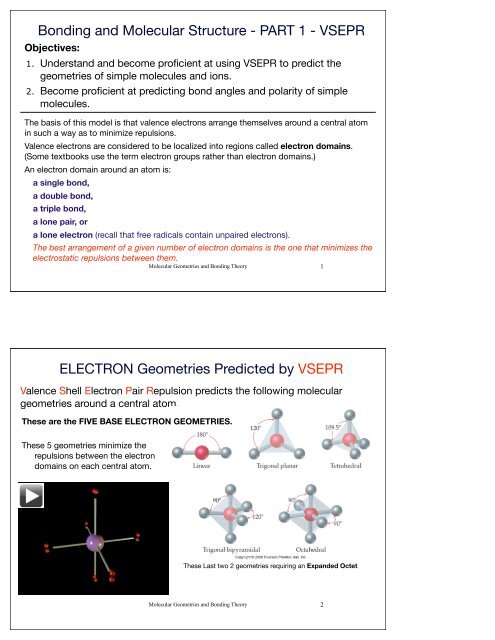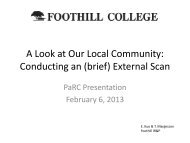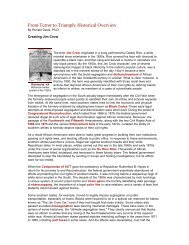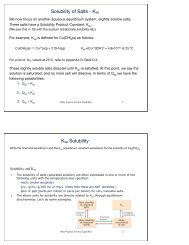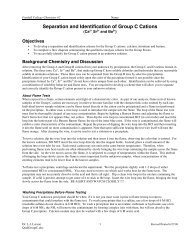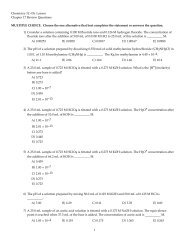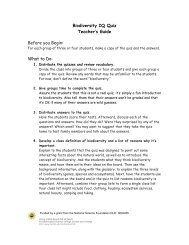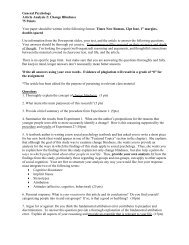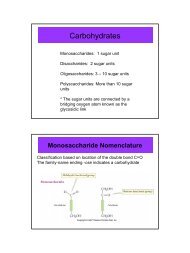Chapter 9 - VSEPR
Chapter 9 - VSEPR
Chapter 9 - VSEPR
Create successful ePaper yourself
Turn your PDF publications into a flip-book with our unique Google optimized e-Paper software.
Bonding and Molecular Structure - PART 1 - <strong>VSEPR</strong><br />
Objectives:<br />
1. Understand and become proficient at using <strong>VSEPR</strong> to predict the<br />
geometries of simple molecules and ions.<br />
2. Become proficient at predicting bond angles and polarity of simple<br />
molecules.<br />
The basis of this model is that valence electrons arrange themselves around a central atom<br />
in such a way as to minimize repulsions.<br />
Valence electrons are considered to be localized into regions called electron domains.<br />
(Some textbooks use the term electron groups rather than electron domains.)<br />
An electron domain around an atom is:<br />
a single bond,<br />
a double bond,<br />
a triple bond,<br />
a lone pair, or<br />
a lone electron (recall that free radicals contain unpaired electrons).<br />
The best arrangement of a given number of electron domains is the one that minimizes the<br />
electrostatic repulsions between them.<br />
Molecular Geometries and Bonding Theory 1<br />
ELECTRON Geometries Predicted by <strong>VSEPR</strong><br />
Valence Shell Electron Pair Repulsion predicts the following molecular<br />
geometries around a central atom.<br />
These are the FIVE BASE ELECTRON GEOMETRIES.<br />
These 5 geometries minimize the<br />
repulsions between the electron<br />
domains on each central atom.<br />
These Last two 2 geometries requiring an Expanded Octet<br />
Molecular Geometries and Bonding Theory 2
Example Electron Domain Geometry - Tetrahedral<br />
From the Lewis Structure we can count<br />
electron domains around the central atom.<br />
The number of electron domains<br />
determines the basic arrangement of the<br />
electron domains around the central atom.<br />
In this case four electron domains (4 single<br />
bonds) gives the tetrahedral geometry<br />
with bond angles of 109.5°<br />
To determine the geometry around a<br />
central atom you must first be able to draw<br />
the LEWIS STRUCTURE!<br />
Tetrahedral<br />
Molecular Geometries and Bonding Theory 3<br />
Details of the 5 Base Electron Domain Geometries from<br />
<strong>VSEPR</strong><br />
Bond angles are the angles made by the lines<br />
joining the nuclei of the atoms in a molecule.<br />
Each of the five basic geometries has specific<br />
bond angles associated with it that you must<br />
memorize (see Table 9.1). These “ideal” bond<br />
angles may be distorted by certain conditions as<br />
we shall see later.<br />
Molecular Geometries and Bonding Theory 4
The MOLECULAR GEOMETRY describes the spatial arrangement of ATOMS<br />
around a central atom. This is a subset of the ELECTRON GEOMETRY<br />
The arrangement of electron domains about a central atom is called the electron-domain<br />
geometry (or electron-group geometry) as previously discussed.<br />
The molecular geometry is the arrangement of only the atoms in a molecule or<br />
polyatomic ion.<br />
All Electron Domains counted<br />
Molecular Geometries and Bonding Theory 5<br />
Molecular Geometries and Bonding Theory 6<br />
Only Bonds counted,<br />
lone pairs ignored<br />
Details of Molecular Geometries Derived from Linear and<br />
Trigonal Planar Electron Domain Geometries
Details of Molecular Geometries Derived from a<br />
Tetrahedral Electron Domain Geometry<br />
Molecular Geometries and Bonding Theory 7<br />
Details of Molecular Geometries Derived from a Trigonal<br />
Bipyramidal Electron Domain Geometry<br />
Molecular Geometries and Bonding Theory 8
Details of Molecular Geometries Derived from an<br />
Octahedral Electron Domain Geometry<br />
Molecular Geometries and Bonding Theory 9<br />
<strong>VSEPR</strong> Bond Angle Detail #1:<br />
Lone Pairs and Slight Changes to Bond Angles<br />
Lone pairs on a central atom will cause the bonding groups to move closer<br />
together, decreasing the bond angle. Lone pairs occupy more space and<br />
are more repulsive than bonding pairs.<br />
Decrease in bond angle as lone pairs are added<br />
Molecular Geometries and Bonding Theory 10<br />
Less<br />
repulsive<br />
More<br />
repulsive
<strong>VSEPR</strong> Bond Angle Detail #2:<br />
Double Bonds Change Bond Angles<br />
A double bond on a central atom cause adjacent single bonding groups to move closer<br />
together, decreasing the bond angle between them. Double bonds occupy more space and<br />
are more repulsive than single bonds.<br />
Give It Some Thought<br />
One of the resonance structures of the nitrate ion, NO 3– , is<br />
The bond angles in this ion are exactly 120°. Is this<br />
observation consistent with the above discussion of the<br />
effect of multiple bonds on bond angles<br />
Conclusion for Repulsive Energies:<br />
Lone Pair > Double Bond > Single Bond > Single e –<br />
Molecular Geometries and Bonding Theory 11<br />
More <strong>VSEPR</strong> Details:<br />
5 Electron Groups and Axial vs. Equatorial Positions<br />
When we form the trigonal bipyramidal electron domain<br />
geometry we have inequivalent bonding positions, axial<br />
and equatorial.<br />
Lone pairs prefer the equatorial positions since they<br />
minimize the strong 90° repulsions for the lone pairs.<br />
Seesaw Geometry<br />
Equatorial<br />
lone pairs<br />
Molecular Geometries and Bonding Theory 12<br />
1 lone pair<br />
2 lone pairs<br />
3 lone pairs
Geometries of Larger Molecules<br />
The <strong>VSEPR</strong> model can be extended to consider every central<br />
atom in a more complex, larger molecule.<br />
Consider Acetic Acid:<br />
Molecular Geometries and Bonding Theory 13<br />
Molecular Geometries of Complex Molecules - DNA<br />
Molecular Geometries and Bonding Theory 14
Dipole Moments and Polar Molecules<br />
Many molecules are polar. They have a dipole moment and will align<br />
themselves in an applied electric field.<br />
Polar molecule<br />
No alignment<br />
Alignment<br />
Molecular Geometries and Bonding Theory 15<br />
Dipole Moments for Polyatomic Molecules<br />
For a molecule that consists of more than two atoms (a polyatomic molecule), the<br />
dipole moment depends upon both the individual bond polarities and the molecular<br />
geometry.<br />
• Bond dipoles and dipole moments are vector quantities; that is they have both a<br />
magnitude and a direction.<br />
• The overall dipole moment of a polyatomic molecule is the vector sum of the bond<br />
dipoles. Both the magnitudes and the directions of the bond dipoles must be considered.<br />
(Molecular Geometry analysis is necessary!)<br />
• It is possible to have a nonpolar molecule that contains polar bonds if the polar bond<br />
dipoles are arranged in such a way as to “cancel” each other.<br />
Molecular Geometries and Bonding Theory 16
Dipole Moment Depends on Bond Polarity and Electron Geometry<br />
To have a dipole moment a molecule must have:<br />
1. Polar bonds and/or lone pairs.<br />
2. A molecular geometry where the polar bonds/lone pairs do not<br />
cancel.<br />
Polar bonds cancel Polar bonds do not cancel<br />
Molecular Geometries and Bonding Theory 17<br />
Polarity of Some Molecules<br />
Give It Some Thought<br />
The molecule OCS has a Lewis structure analogous to that of CO 2 and is a linear molecule.<br />
Will it necessarily have a zero dipole moment like CO 2?<br />
Molecular Geometries and Bonding Theory 18
Polarity of Molecules<br />
Dipole Moments of Some Molecules<br />
Molecular Geometries and Bonding Theory 19<br />
Predicting Electron Domain Geometries, Molecular Geometries, Bond<br />
Angles and Dipole Moments<br />
We can generalize the steps we follow in using the <strong>VSEPR</strong> model to predict the electron<br />
domain geometries, molecular geometries, bond angles and dipole moments. Use the<br />
<strong>VSEPR</strong> worksheet to guide you as you learn this process.<br />
1. Draw the Lewis structure of the molecule or ion, and count the total number of electron domains around the<br />
central atom. Each nonbonding electron pair, each single bond, each double bond, and each triple bond counts<br />
as an electron domain.<br />
2. Determine the electron-domain geometry by arranging the electron domains about the central atom so that the<br />
repulsions among them are minimized, as shown in Table 9.1.<br />
3. Use the arrangement of the bonded atoms to determine the molecular geometry as shown in Tables 9.2 and 9.3.<br />
4. Look at the arrangement and types of electron domains. Predict if any bond angles will vary from their “ideal<br />
values”.<br />
5. Determine if the molecule has a net dipole moment. Use the flow diagram on the <strong>VSEPR</strong> worksheet. Note: Since<br />
IONS have a nonzero charge, dipole moments do not apply.<br />
Molecular Geometries and Bonding Theory 20
Problem 1: Acrolein<br />
1. Give the molecular geometry around each central atom.<br />
2. Identify all bonds as polar or nonpolar.<br />
3. Does this molecule have a net dipole moment?<br />
Molecular Geometries and Bonding Theory 21<br />
Problem 2: Acetonitrile<br />
1. Give the molecular geometry around each central atom.<br />
2. State the indicated bond angles.<br />
3. Identify all bonds as polar or nonpolar.<br />
4. Does this molecule have a net dipole moment?<br />
Molecular Geometries and Bonding Theory 22
Problems<br />
Text question 9.3: An AB 5 molecule adopts the geometry shown to the right.<br />
(a) What is the name of this geometry?<br />
(b) Do you think there are any nonbonding electron pairs on atom A? Why or why<br />
not?<br />
(c) Suppose the atoms B are halogen atoms. Can you determine uniquely to<br />
which group in the periodic table atom A belongs?<br />
Text question 9.18: The AB 3 molecule is described as having a trigonal-bipyramidal electron-domain<br />
geometry. How many nonbonding domains are on atom A? Explain<br />
Molecular Geometries and Bonding Theory 23<br />
Problems<br />
Text question 9.28: The three species NH 2 − , NH3 , and NH 4 + , have H–N–H bond angles of 105°, 107°,<br />
and 109°, respectively. Explain this variation in bond angles.<br />
Additional Question: Dichloroethylene (C 2 H 2 Cl 2 ) has three forms (isomers), each of which is a different<br />
substance. A pure sample of one of these substances is found experimentally to have a dipole<br />
moment of zero. Can we identify which of the three isomers was used?<br />
Molecular Geometries and Bonding Theory<br />
23 24


